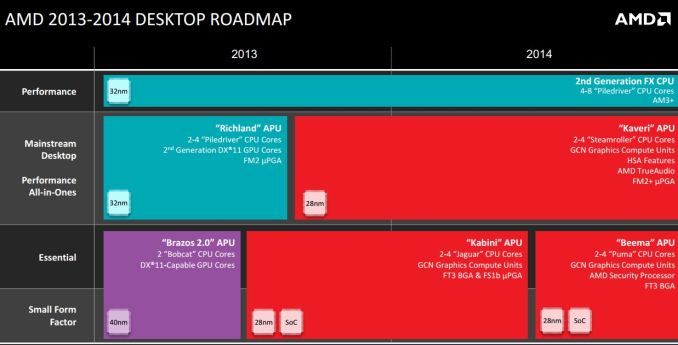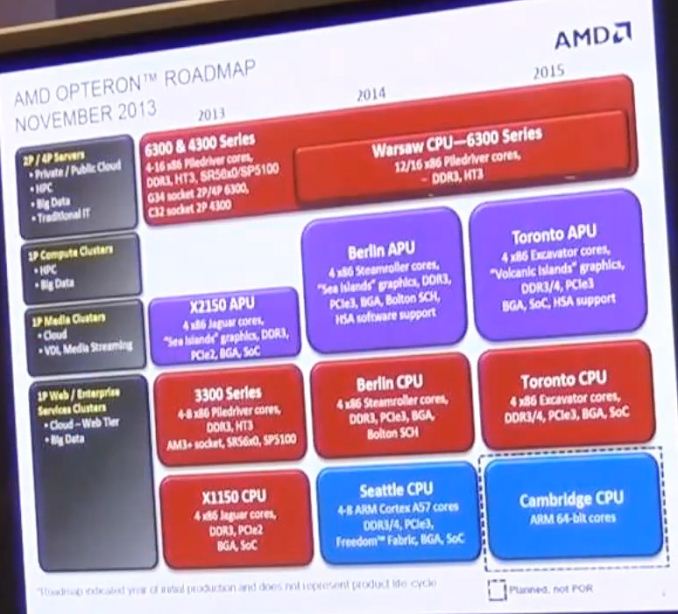AMD Kaveri Review: A8-7600 and A10-7850K Tested
by Ian Cutress & Rahul Garg on January 14, 2014 8:00 AM ESTSocket: FM2+
The new Kaveri processors are built to use the sort-of new FM2+ socket based motherboards. These motherboards fit both FM2+ and FM2 APUs, and thus have been on the market for a good number of months already. However the boards currently on the market may require a BIOS update, and e-tailers shipping motherboards out today may still have the older not-updated revisions in stock, so it is worth confirming that the motherboard you order is updated.
AMD’s generational split on Kaveri is indicative of market pressure and AMD’s history – users like either the processor or the motherboard to be forwards or backwards compatible in terms of compliance. In this case the following table applies:
| Socket Compatibility Chart | ||
| Will Work in FM2 | Will Work in FM2+ | |
| Richland | Yes | Yes |
| Kaveri | No | Yes |
As Kaveri comes with two extra pins that are blocked off with older FM2 motherboards, they are not compatible.
For our testing today, we had sourced the ASRock FM2A88X Extreme6+ and FM2A88X-ITX+ motherboards, both of which will be the focus for review in due course.
Chipset/FCH: A55, A78, A88X
To add some confusion into the mix, AMD is using a mixture of old and new chipsets on FM2+. Kaveri will support the A55, A78 and A88X chipset based motherboards, but not the A75 chipset that was used for Llano/FM1 motherboards. Perhaps more confusing is that while the old Richland APUs will be able to be used on FM2+ with A88X, the older FM2 motherboards will not come with A88X. How about a table to make it clearer:
| Chipset Compatibility Chart | |||
|
Will Work with Llano APUs |
Will Work with Trinity & Richland APUs |
Will Work with Kaveri APUs |
|
| A55 + FM1 | Yes | No | No |
| A55 + FM2 | No | Yes | No |
| A55 + FM2+ | No | Yes | Yes |
| A75 + FM1 | Yes | No | No |
| A75 + FM2 | No | Yes | No |
| A78 + FM2+ | No | Yes | Yes |
| A85X + FM2 | No | Yes | No |
| A88X + FM2+ | No | Yes | Yes |
Though even a table doesn't make the compatibility matrix crystal-clear, it does help to make sense of what users can expect for chipset and sock compatibility. Basically, any A88X motherboard you buy will fit the Kaveri APU. For A78, we are currently under the impression that these will be FM2+ only as well, just do not get confused with older ‘AMD 780L’ Northbridge chipsets that were advertised with A78 in the motherboard name that used the AM3 socket. A55 is almost a free-for-all, with FM1 and FM2 motherboards using it.
As for the differences between the older A85X and A88X chipsets, there are only a few to speak of. Support for PCIe 3.0 is the big one, with any FM2+ and A88X motherboard and Kaveri APU taking full advantage of PCIe 3.0 in all its glory, either as an x16 slot or an x8/x8. A88X still has eight 6 Gbps ports and four USB 3.0 ports native, as well as supporting RAID 0, 1, 5 and 10. The other only upgrade to note is the move to XHCI 1.0.
| Chipset Comparison | |||||
| A55 | A75 | A78 | A85X | A88X | |
| Chipsets |
FM1 FM2 FM2+ |
FM1 FM2 |
FM2+ | FM2 | FM2+ |
| PCIe Generation | 2.0 | 2.0 | 2.0 | 2.0 | 3.0 |
| PCIe Lane Allocation | 1x16 | 1x16 or 2x8 | 1x16 | 1x16 or 2x8 | 1x16 or 2x8 |
| SATA 6/3 Gbps | 0 + 6 | 6 + 0 | 6 + 0 (?) | 8 + 0 | 8 + 0 |
| USB Ports (3/2/1.1) | 0 + 14 + 2 | 4 + 10 + 2 | 4 + 10 + 2 (?) | 4 + 10 + 2 | 4 + 10 + 2 |
| RAID | 0, 1, 10 | 0. 1, 5, 10 | 0. 1, 5, 10 | 0. 1, 5, 10 | 0. 1, 5, 10 |
| TDP | 7.6 W | 7.8 W | 7.8 W ? | 7.8 W | 7.8 W ? |
Unusually for AMD, little information about chipset evolution was provided through the normal channels.
What about FX CPUs, or Server CPUs?
Leaked roadmaps have not been kind to AMD’s FX range. The ‘king’ of the Vishera family of FX CPUs, the quad-module eight-thread FX-9590, looks like it will be the king of the FX line for a little while longer, as shown in this roadmap:
As you might imagine, there is no public comment from AMD about the lack of new FX CPUs with Steamroller cores coming soon.
Depending on which roadmap you look at, AMD’s server offerings are mixed. Some report that During 2014 we will see the launch of “Warsaw” CPUs featuring 12-16 Piledriver cores, and there is no current mention of high-end Steamroller based Opterons at all. The official roadmap from AMD from June shows this, including their ARM server discussion, but a recently leaked roadmap shows that Steamroller will appear in their 1P compute clusters, followed by Excavator in 2015, but Piledriver based 12-16 thread machines will stay at the top of the pile.













380 Comments
View All Comments
DryAir - Tuesday, January 14, 2014 - link
So at playble settings (30 fps+) kaveri is no better than richland. And both get outperformed by Iris Pro.jeffkibuule - Tuesday, January 14, 2014 - link
That CPU with Iris Pro costs $450 compared to these AMD chips which are far less expensive.takeship - Tuesday, January 14, 2014 - link
Only if you spring for the i7 variant. The i5 variant is ~300$. Still a premium over Kaveri, but you're also getting nearly double the CPU power.mr_tawan - Tuesday, January 14, 2014 - link
Also Iris comes only with R-variant of i5/i7. It won't run on your mainboard, so forget about DIY machine. You can always get a dGPU for that kind of machine though.just4U - Tuesday, January 14, 2014 - link
Is that why you can't buy the R variant at the usual places? I wasn't even aware that they are not compatible with regular 1150 boards.. hmmm.. that's to bad. I just thought they were in low supply or going to OEMs before they hit the retail channels.Gigaplex - Wednesday, January 15, 2014 - link
I'm pretty sure they only come in soldered-on variants.Klimax - Friday, January 17, 2014 - link
Correct, however some rumors say, that it won't be case with Broadwell/Haswell-refresh anymore. (Depends who is correct)thevoiceofreason - Tuesday, January 14, 2014 - link
Precisely. All those percentage improvement at 1080p graphs look very nice but are in the end moot if you realize you are looking at 12fps.At the end of the day, you can barely play at 720p.
methebest - Tuesday, January 14, 2014 - link
he needed to test them on low settings at 1080p.Principle - Tuesday, January 14, 2014 - link
Thats because they dont do these APUs any justice with their review strategy. They basically want to push GPUs, so they do not highlight the APU's actual capabilities. For example, how about some qualitative subjective analysis, rather than all of this easily comparative quantitative nonsense. I want to know at 1080p, what settings have to be turned down to be playable. Why in the world would they run these at Extreme settings??? Its absurd, unless you're trying to sell dGPUs. Where the AMD solutions really have an advantage is in the details. You likely can turn off AA and see the AMD FPS double, without nearly as big of jump by the Intel IGP where you would likely have to turn everything off or on low.